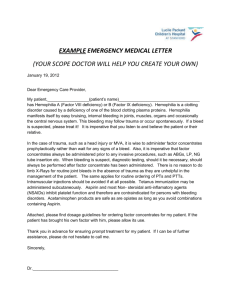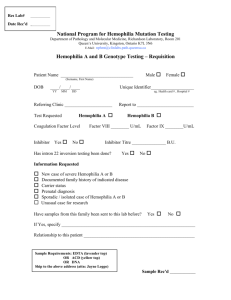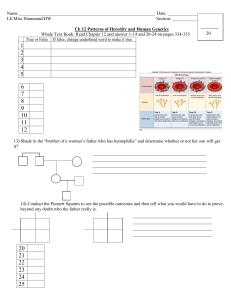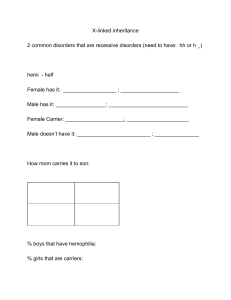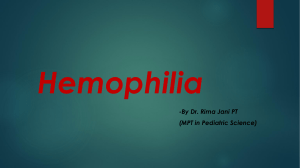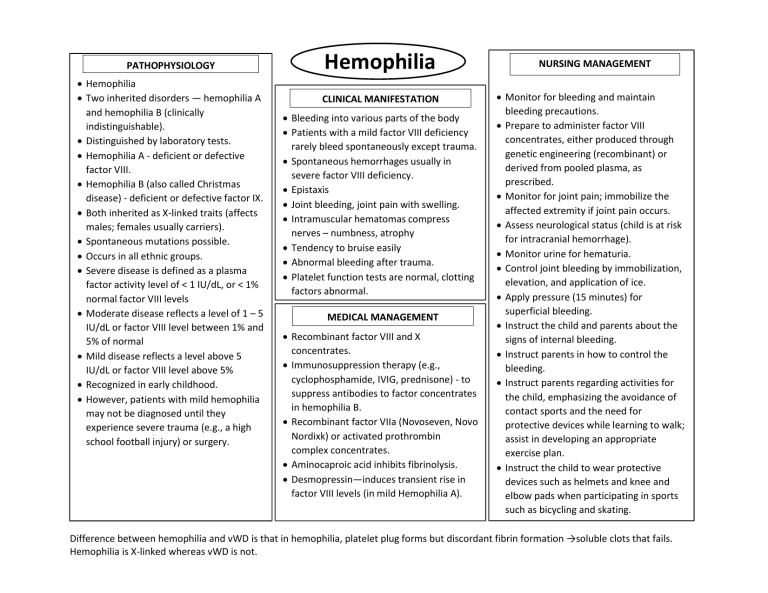
PATHOPHYSIOLOGY Hemophilia Two inherited disorders — hemophilia A and hemophilia B (clinically indistinguishable). Distinguished by laboratory tests. Hemophilia A - deficient or defective factor VIII. Hemophilia B (also called Christmas disease) - deficient or defective factor IX. Both inherited as X-linked traits (affects males; females usually carriers). Spontaneous mutations possible. Occurs in all ethnic groups. Severe disease is defined as a plasma factor activity level of < 1 IU/dL, or < 1% normal factor VIII levels Moderate disease reflects a level of 1 – 5 IU/dL or factor VIII level between 1% and 5% of normal Mild disease reflects a level above 5 IU/dL or factor VIII level above 5% Recognized in early childhood. However, patients with mild hemophilia may not be diagnosed until they experience severe trauma (e.g., a high school football injury) or surgery. Hemophilia CLINICAL MANIFESTATION Bleeding into various parts of the body Patients with a mild factor VIII deficiency rarely bleed spontaneously except trauma. Spontaneous hemorrhages usually in severe factor VIII deficiency. Epistaxis Joint bleeding, joint pain with swelling. Intramuscular hematomas compress nerves – numbness, atrophy Tendency to bruise easily Abnormal bleeding after trauma. Platelet function tests are normal, clotting factors abnormal. MEDICAL MANAGEMENT Recombinant factor VIII and X concentrates. Immunosuppression therapy (e.g., cyclophosphamide, IVIG, prednisone) - to suppress antibodies to factor concentrates in hemophilia B. Recombinant factor VIIa (Novoseven, Novo Nordixk) or activated prothrombin complex concentrates. Aminocaproic acid inhibits fibrinolysis. Desmopressin—induces transient rise in factor VIII levels (in mild Hemophilia A). NURSING MANAGEMENT Monitor for bleeding and maintain bleeding precautions. Prepare to administer factor VIII concentrates, either produced through genetic engineering (recombinant) or derived from pooled plasma, as prescribed. Monitor for joint pain; immobilize the affected extremity if joint pain occurs. Assess neurological status (child is at risk for intracranial hemorrhage). Monitor urine for hematuria. Control joint bleeding by immobilization, elevation, and application of ice. Apply pressure (15 minutes) for superficial bleeding. Instruct the child and parents about the signs of internal bleeding. Instruct parents in how to control the bleeding. Instruct parents regarding activities for the child, emphasizing the avoidance of contact sports and the need for protective devices while learning to walk; assist in developing an appropriate exercise plan. Instruct the child to wear protective devices such as helmets and knee and elbow pads when participating in sports such as bicycling and skating. Difference between hemophilia and vWD is that in hemophilia, platelet plug forms but discordant fibrin formation →soluble clots that fails. Hemophilia is X-linked whereas vWD is not. NURSING MANAGEMENT contd. GERONTOLOGICAL CONSIDERATION Splints & other orthopedic devices helps joint or muscle bleeding. All injections should be avoided; Minimize invasive procedures (e.g., endoscopy) or give factor replacement first. Wear medical identification (e.g., MedicAlert bracelets). Written emergency plan (what to do in emergency including names and phone numbers). Heat is avoided because it can accentuate bleeding. HIV and hepatitis C, counseling for patients prior to 1985 Genetic testing and counseling should be provided to female carriers. Intracranial hemorrhage is the third most common cause of death after HIV and hepatitis. Hepatitis B and C infections are very common in this population. Likelihood of acquiring inhibitors, especially hemophilia A inhibitors, also increases with age. Arthropathy is a major cause of morbidity. Pain management can be challenging as NSAID use is contraindicated. Concomitant cardiovascular disease less likely but interventions challenging when they occur. Substances that Impair Platelet Formation Miscellaneous Antihistamines Hepatitis B vaccine Phenytoin (Dilantin) Vitamin E Herbal Supplements Feverfew Gingko Ginseng Kava kava Food and Food Additives Caffeine Chinese black tree fungus Clove Cumin Ethanol (i.e., alcohol) Fish oils Garlic Ginger Onion extract Turmeric Plasma Expanders Antibiotics Angiotensin receptor blockers Beta-blockers Calcium channel blockers Diuretics SSRIs, SNRIs, TCAs, Contrast agents Difference between hemophilia and vWD is that in hemophilia, platelet plug forms but discordant fibrin formation →soluble clots that fails. Hemophilia is X-linked whereas vWD is not.
